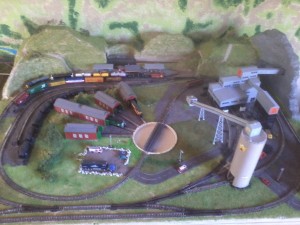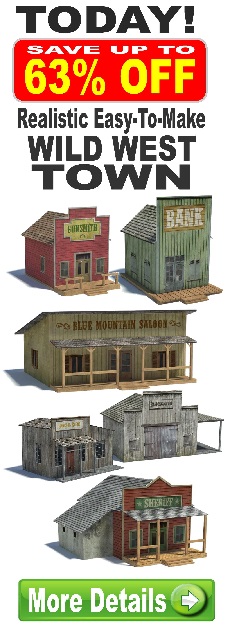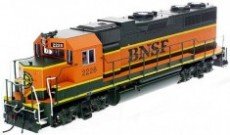Everything on model trains, model railroads, model railways, locomotives, model train layouts, scenery, wiring, DCC and more. Enjoy the world's best hobby... model railroading!
Reverse Loop Issue – Shorts Out
Doug from Northern Australia asks readers:
“Hi, I run HO DCC (NCE 5 amp) and am trying to wire up an MRC auto reverse module. I have a simple loop running back onto a main line, through a set of left hand points (switch) and each time I set the points to the left it shorts out. I have isolated all ends of points, but still the same. I am using insulfrog points. If I run the loco around the leave the points straight ahead the diesel has enough weight to run through the points (downwards) without derailing (carriages would not do so).”
Layout Photos Sent in by Richard
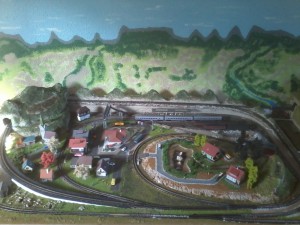
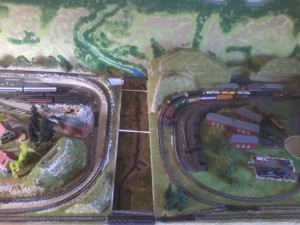 Here are two more photos of Richard’s layout. A third one was posted earlier.
Here are two more photos of Richard’s layout. A third one was posted earlier.
The first photo shows Richville; a Village at the foot of the mountain; Town Center with Shops and a Filling Station; Holiday Homes on the lake shore; and Richville Station.
The second photo; a crossing via Bridges over a Canon.
The layout also features the “New River Mining Company” pictured in the earlier posting.
Does Track Code Cause Derailments?
Herb asks readers:
“I’ve been having derailment issues and a railroad friend of mine claims locos and cars are less likely to derail on Code 100 track, compared to the code 83 track I am using. Is that true? I don’t want to rip up my track if I don’t have to.”
Robert comments: Readers might also like to comment on any differences they’ve personally observed with code 83 vs code 100 in regards to: track thickness, detailing, short circuits, ease of installation.
How To Prevent Model Train Derailments
POLL RESULTS: Do you have relatives who are (or were) model railroaders?
Not so many people as usual participated in last weeks poll which asked: Do you have relatives (parents, brothers/sisters, uncles/aunts, cousins/nieces/nephews, sons/daughters) who are or were model railroaders? The 240 participants voted as follows:
>> NO (65%)
>> YES (30%)
>> I don’t have a layout yet (5%)
How Do You Remove Ballast and Flex Track?
Roy asks readers:
“Is there a way to remove ballast and flex track? I want to replace flex track with Kato track.”
Unfortunately Roy doesn’t give any details of how his track and ballast are applied on his N scale layout. Hopefully he will add a comment to this post giving more detail.
Ordering Train Stuff Online From Where?
Obviously readers will have preferred brands and retailers when it comes to buying model trains, parts and accessories.
Gio is into O scale and asks:
“Do members know of hobby shops or online retailers that are reliable as far as stocking and prompt delivery no hassles competitive shipping rates?”
Perhaps Gio might like to add a comment to this post and tell people where he lives, or at least which country.
How Easy Is It To Convert Old Locos To DCC?
Phil asks readers:
“I have been out of the hobby for about 18 yrs now. I am planning my next layout and am confused on everything I read on DCC, except that DCC seems to be the way to go. With all of my older HO locos is it better to convert them to DCC, or start all over again from scratch and build up another roster of locos with DCC already included? Thanks for the time to respond.”
Send In a Photo of a Building You Made – and get it PUBLISHED!!!
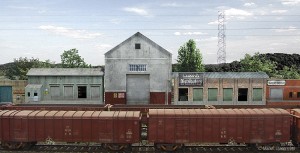 Thank you for all the excellent feedback on the model buildings featured on this blog. It is pleasing to hear such good results!
Thank you for all the excellent feedback on the model buildings featured on this blog. It is pleasing to hear such good results!
Several readers suggested publishing a photo of a building they constructed, to show other how good it looks on their layout, so there is now the opportunity for readers to do that. Details at http://www.modelbuildings.org/photos.html
How To Wire A Double Slip
Jan asks readers:
“How do I wire a Peco SL-E 190 double slip? I have wired each point motor shifting the polarity of the crossing point most close to it. The slip works beautifully as a normal diamond crossing. But, if I activate the second point motor in the travelling direction in order to go to a siding a short circuit occurs when the locomotive reaches the second crossing point due to incorrect polarity. Of course the same problem happens when entering from the opposite direction.”
TRAIN POLL RESULTS: What is your favorite type of freight car?
Our last poll asked: What is your favorite type of freight car?
443 model railroaders took part and the results were as follows:
>> Box (34%)
>> Tank (12%)
>> Hopper (9%)
>> Flat (9%)
>> Refrigerated (9%)
>> Covered Hopper (7%)
>> Gondola (6%)
>> Special Purpose Car (6%)
>> Doublestack/Well (6%)
>> Stock (2%)
Pantographs Not Working
Jack from Canada asks readers:
“Where can I buy working N scale pantographs? I have a GG-1 Kato locomotive but the pantographs keep falling down, no mechanism (springs?) to keep them up. They do not have to supply the current to the motor, that stays on the tracks but it looks dumb to have an electric locomotive without a working pantograph.The Japanese pantographs have no springs in them either and are no help. Please advise.
Power Requirements For 25 Foot Layout
Nicholas asks readers:
“I am in the planning process of a single HO track that will be a rectangular lay out. The two long straight legs will be 25 feet in length each, and the two short legs will be approx. 15 feet each. Only one assembled train will be operating at a time. Concerns; 1. Will I need two power units or one, 2. What type (power rating, model) will be required to power that much track, 3. Will this require multiple power points through out the line. Thank you for your attention.”






